













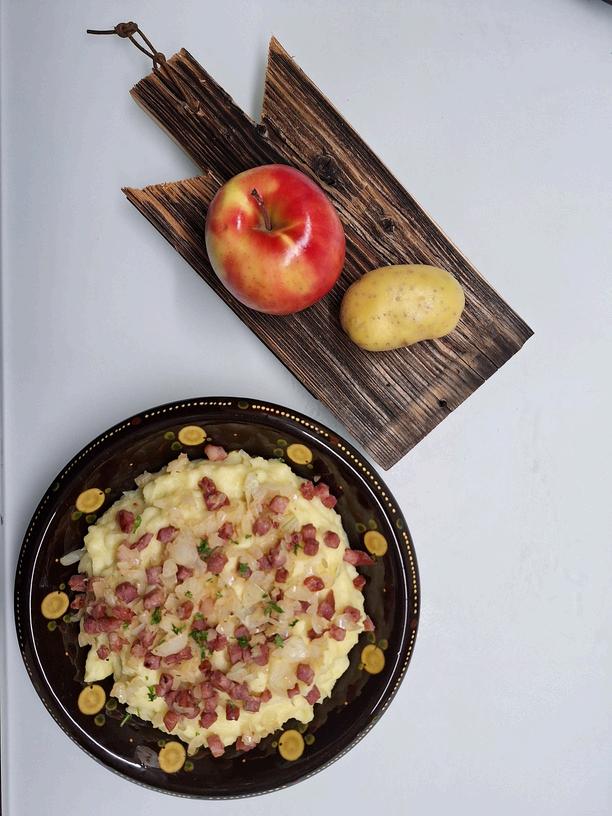

November: the month of bonfires, chilly days, rain, mists, the last of the autumn leaves, golden sunrises and burning sunsets. It’s also the month of adjusting to the shorter days but balancing the darkness out with hygge vibes and festive prep.
We’ve packed this issue with lots of ways to find joy in this season whether you celebrate next month or not. So pour a cup of something warming and get comfy; its time to get inspired.
Have a beautiful November, Anjee xx



It’s that time of year again when the garden centres become Christmas shops and our gardens go to bed for the winter and professional gardeners sit inside consuming their weight in biscuits and drinking copious amount of tea and coffee and we don’t reemerge until spring time.
Obviously I jest, if anything this is the busiest time of year for me in the garden at work as I try and catch up on all the jobs I have been neglecting to do during the growing season: keeping on top of tool maintenance, planning for next year, ordering bare root plants for winter planting, and in my case fixing the roof in the pump shed It’s also the build up to Christmas with 6 weeks of work left in the year

By Marc Ridpath
@gardeneriddler
As we are speaking about Christmas, now is the time to plant your Paperwhite daffodils if you want a festive display All you need to do is plant them in a decorative pot with some compost and then put some moss over the top, then place in a sunny windowsill and you should have some fragrant and beautiful flowers for the festive period.
I have been neglecting to prune a few plants in the garden at work as I am eyeing them up for wreath making material, plants like Holly, Yew, Roses with decorative hips and Hydrangeas with dried flower heads. I usually make about 5 or 6 wreaths for work and for home.



Over the last few years I have been experimenting with the most sustainable way of making a wreath I have found that if you create a weaved willow wreath out of 15 stems this creates a structure that you can push ever green stems into without the need for moss or wire I was amazed just how long the wreaths looked good for, it was well in to the new year
Seed heads are a great way to give your wreaths the wow factor, my absolute favourite is Telekia speciosa they look like golden velvet buttons Another fantastic addition is dried Allium flowers they look like stars I also tried adding red Cornus stems to my wreaths last year and thought this was another game changer.

Another gorgeous stem to use is twisted Hazel, especially if you can get some with the catkins on the stems. I realise I am very much like a child in a sweet shop working in a 12 acre garden so I am spoilt for choice.
My favourite thing about not using wire is you can just pull the stems out when your done with the wreath and put all the material on your compost heap and save the willow ring to make your wreath again next year I have also saved all of the Telekia seed heads from my wreaths last year to use again this year and they still look amazing
A few more plants that I like to use are Trachelospermum jasminoides or Star Jasmine this plant tends to get red leaves in the winter that add a great extra dimension to your wreath The next one is spiky but looks worth it after a little de-thorning it is of course Teasel I grow these plants in my garden I started them originally from seed but now they self seed freely every year and I just remove any unwanted plants In a wreath, they look like cone but golden in colour Really easy to use because of the stem no need to add wires to attach like pine cones. Finally don’t forget Ivy both for foliage and flowers if you can find any as they are white and like miniature allium flowers.
I hope that I have given you some inspiration to create your own wreath from your garden or foraged from your local area. Be playful, give anything a try, you can always take it out again. Everyone’s tastes are different so give your doors a personal touch this year.

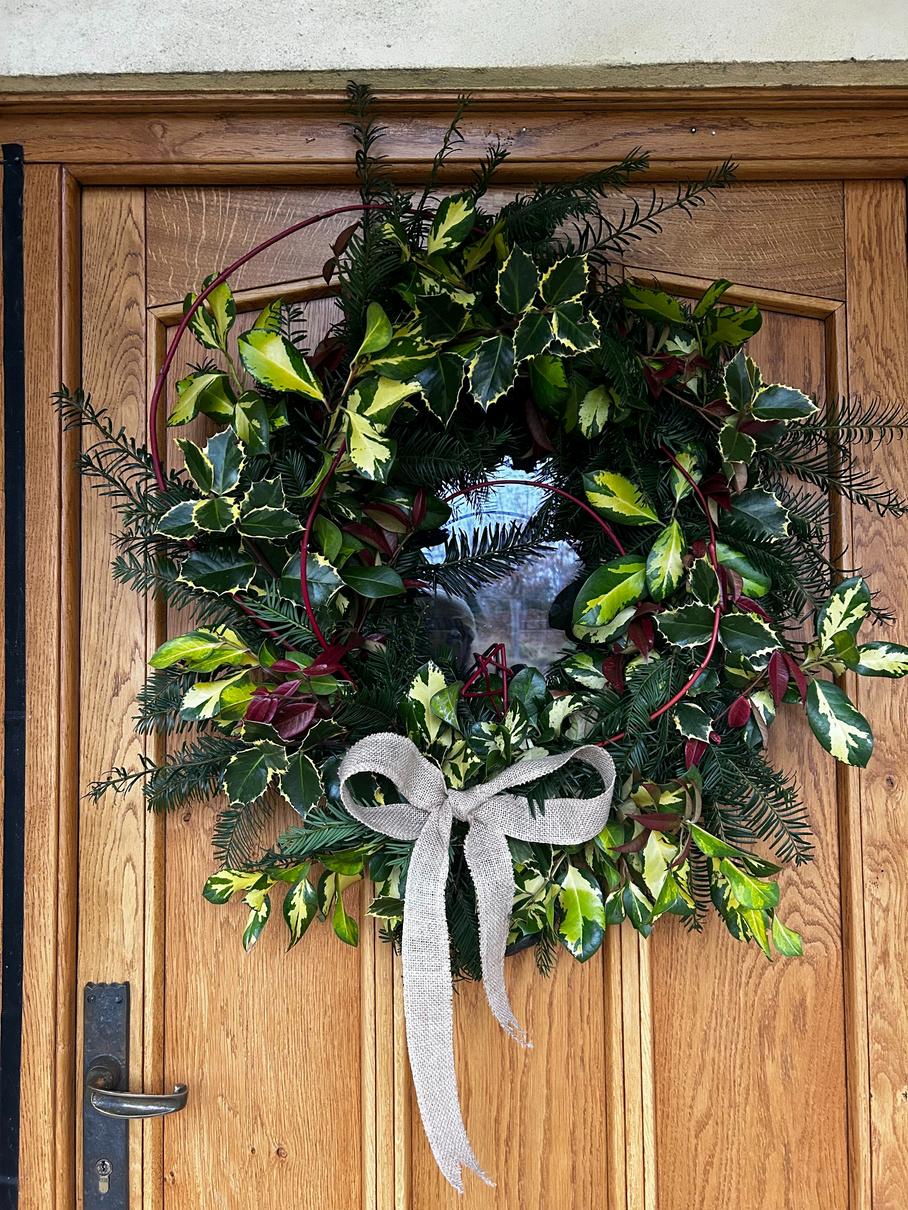


As gardeners, we spend much of looking forward to spring the se renewal, colour, and life. But whe reach the darkest part of the cale with short days and long nights, t longing becomes especially stron While the garden outside may be indoors we can coax a little sprin magic into bloom. Many of us tur amaryllis or hyacinths, but there’s deserves a place in your winter h daffodil

These elegant, fragrant flowers are a perfect way to bring brightness and beauty into your home during the festive season Their crisp white blooms and sweet scent evoke the freshness of spring, even as the frost settles outside And best of all? They’re incredibly easy to grow indoors
Paperwhites make a wonderful gift for anyone who loves plants, flowers, or simply a bit of seasonal cheer They’re widely available now thanks to their growing popularity and can be found in most garden centres, online retailers, and even supermarkets. Packaged with a stylish container and a few pebbles, they make a charming and lowmaintenance present that’s sure to delight.
Unlike many other bulbs, Paperwhites don’t require chilling before planting, which means they’re ready to go as soon as you bring them home. Watching them grow day by day adds a sense of anticipation and joy perfect for the lead-up to Christmas
If you want your Paperwhites to bloom in time for Christmas, timing is key These bulbs typically take three to five weeks to flower after planting For blooms throughout December, aim to plant them around mid-November If you ’ re hoping for flowers on Christmas Day, then planting them around the 1st of December is ideal
Keep in mind that temperature and light can influence their growth rate Warmer rooms may encourage faster blooming, while cooler spots might slow them down slightly So if you ’ re cutting it close, placing them in a warmer area for the first week or two can help speed things along.
There are several ways to grow Paperwhites indoors, and each method offers its own aesthetic appeal:
This is the most popular and visually striking method Place a layer of gravel or decorative stones in a tall vase or glass container Nestle the bulbs into the gravel, pointy side up, and add water until it just touches the base of the bulbs They don’t need soil just moisture and light
Alternatively, you can plant them in a shallow pot with well-draining soil This gives a more natural look, but be prepared to support the stems Paperwhites can grow quite tall and may become top-heavy Use short canes, twigs, or even festive ribbon to tie them gently together. Don’t be afraid to get creative this is a great opportunity to add a seasonal touch to your display.
Paperwhites thrive in bright, indirect light and prefer cooler temperatures ideally below 18°C (65°F) A cool windowsill is perfect Avoid placing them near radiators or heat sources, as this can cause them to grow too quickly and become leggy or floppy
If they do start to flop, don’t worry You can support them with decorative stakes or try the alcohol trick: once the shoots are about 3 inches tall, water them with a mix of 1 part alcohol (vodka or gin) to 7 parts water This stunts their height slightly without affecting the blooms

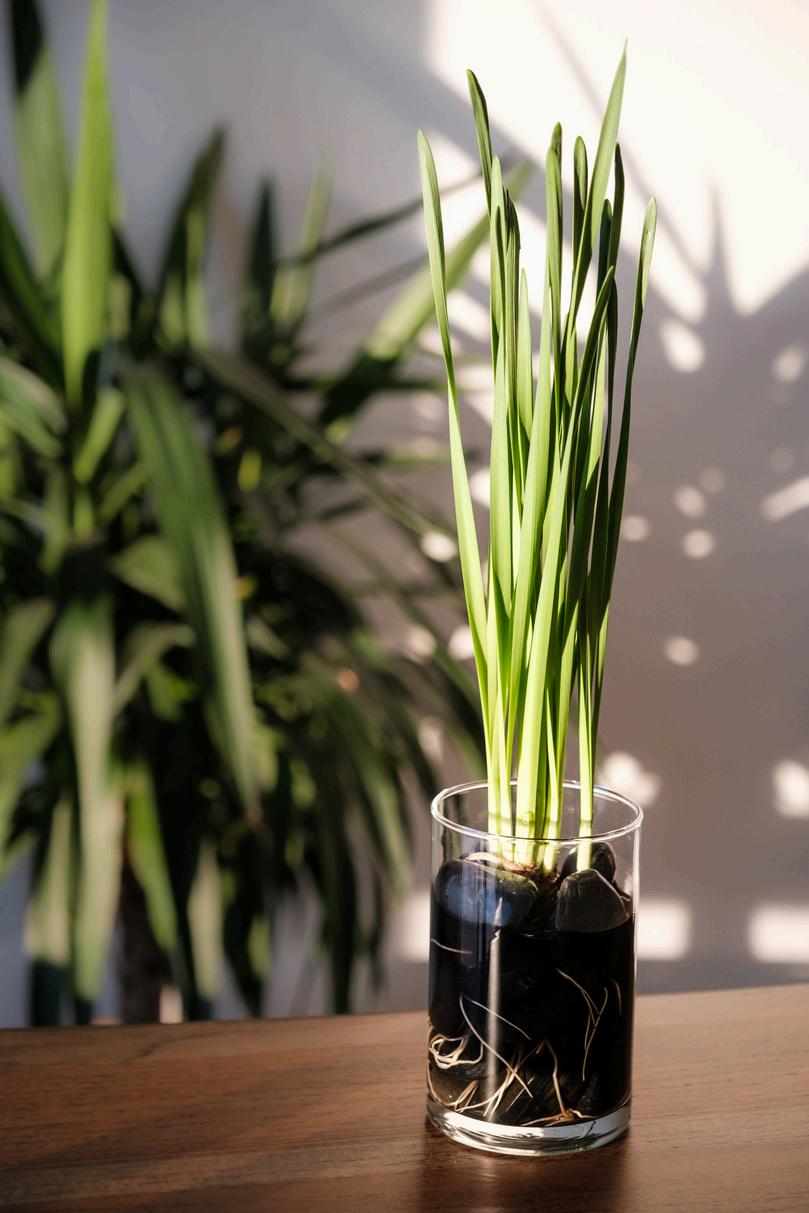
Once the flowers fade, many people wonder what to do with their Paperwhite bulbs. Unlike other daffodils, Paperwhites grown indoors rarely reflower the following year. However, you can try planting them outside in spring. Choose a sunny, well-drained spot in the garden and plant them about 4 inches deep.
Success is hit or miss Personally, I’ve not had much luck with them reflowering outdoors, but it’s worth a try if you don’t want to compost them At the very least, it gives them a chance to return to nature
Paperwhite daffodils are a simple yet stunning way to bring a bit of spring into your home during the festive season Whether you grow them for yourself or gift them to someone special, they offer a burst of brightness and fragrance when we need it most With just a little planning and creativity, you can enjoy their blooms right through Christmas and maybe even inspire a new seasonal tradition.
If you want to follow a step by step Guide on how to grow your paperwhites this year, don’t forget to head over to my Instagram page to find out more.

By Kim O’Brien @garden.with.kim


This festive season, why not take a step back from the pressure of perfect décor and embrace a simpler, more sustainable way to celebrate? By using natural, foraged items from your garden, and a few, carefully chosen embellishments, you can create beautiful, eco-friendly decorations that reduce waste and stress. Think pine cones, holly, ivy, rosemary, and even dried citrus slices for charming, fragrant, rustic touches that bring the outdoors in With just a few thoughtful elements, you can rustle up eyecatching table favours in under five minutes – finishing touches that will add the wow factor without the worry. It’s all about minimal effort for maximum impact, proving that a calm, conscious Christmas can be just as magical and memorable.


ative way to present the table silver on the feel extra special. These can be made the e, and it’s a great crafting project with the s. It might even become a new tradition…


red your 3 ether at their e so that they ape
Gather three leaves. I’ve used Bay (Laurus nobilis), Rosemary (Salvia rosemarinus) and Lambs ears (Stachys byzantine). You can use others of your choice such as holly, pine, eucalyptus etc depending what you have readily available, but I’ve chosen mine because there will be several children and 3 dogs in my house on Christmas day so I want to avoid anything sharp like holly or anything harmful by ingestion
Rosemary is a wonderful choice because it is so fragrant and smells very ‘Christmassy’, especially when mixed with other traditional ingredients which will be

Take a dried c lime depending on your preferred colour scheme) and wire it at the middle Add in a stick of cinnamon and twist the wire tightly before attaching to the fan of leaves The combination of cinnamon, orange and rosemary is fantastic and very evocative of Christmas I can feel myself wanting to reach for a mulled juice already!


Finally Tie your beautiful, fragrant, foraged and embellished creation to the cutlery using a beautiful ribbon. I’ve opted for velvet red ribbon tied in an open granny knot, but you could use a gold or green ribbon tied in a bow here too.
Add any other embellishments you would like to make this unique to you. If you are making multiple table settings, I would make a mixture of variations, rather than trying to make them all look exactly the same This takes the stress out of the process Working with natural materials, which are all different sizes and shapes, the end products will never look identical, so by deliberately creating variations, it makes everything look purposeful and unified I’ve added a metal bell Cheaper plastic bells are available but I wanted to avoid plastic and the metal bell can be saved and re-used forever. I’ve also added a resin berry. I love the look of real berries at Christmas but often they are toxic, messy and/or get trodden into the carpet, so this is one occasion when I would advocate using a small re-usable embellishment which can be kept and re-purposed forever.




Some of last year’s favourites are back and there are some new goodies too to get you feeling festive and provide lots of great gifting options.






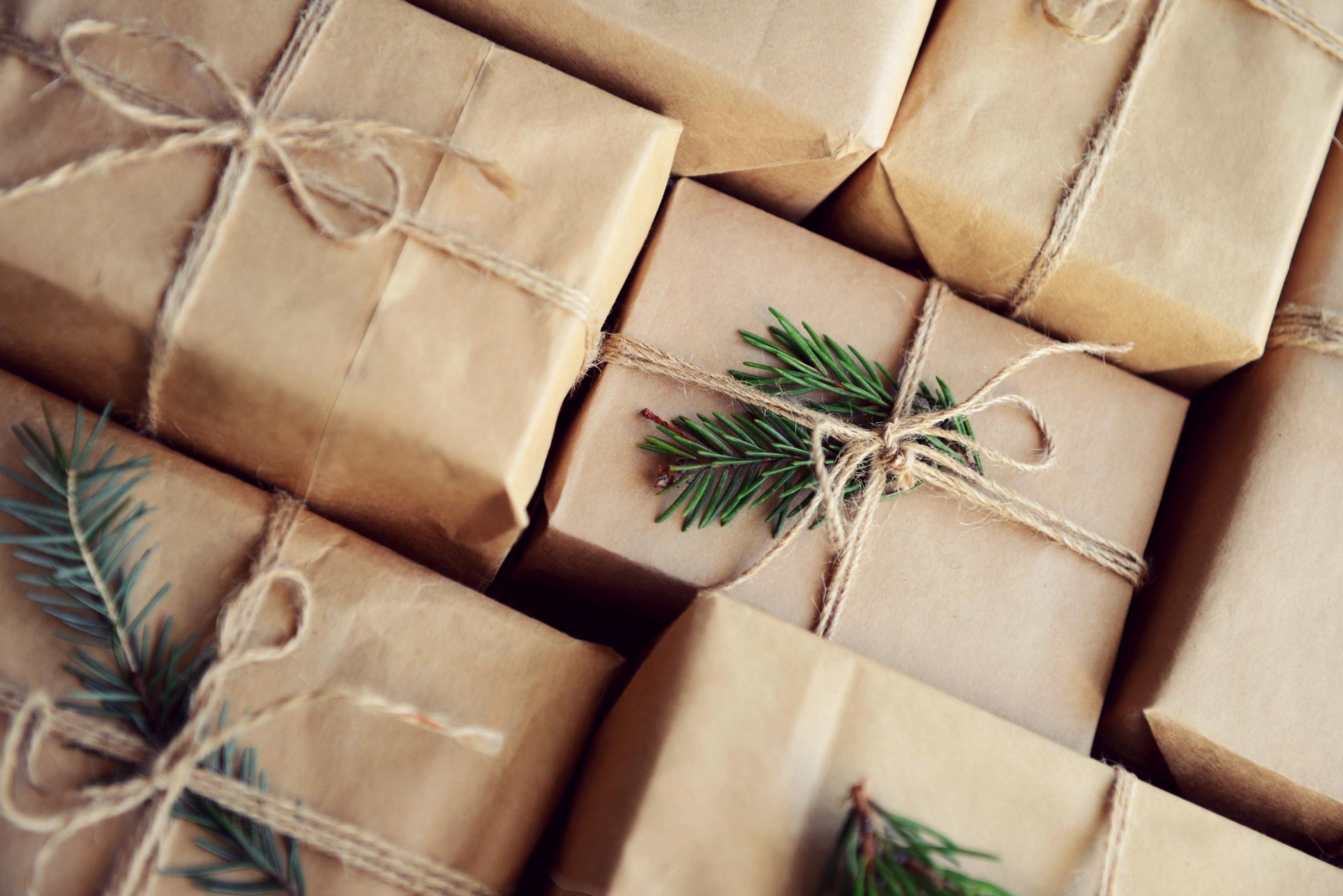
It is always around this time of year when I feel most creative. I think it is the weather as there is nothing better than a cold, rainy, weekend afternoon to make you want to pour a cup of coffee and wile away a few hours creating something new. The autumnal decorations and the Christmassy crafts; I love them all.



Throughout this year I have enjoyed experimenting with seed paper and discovering all the items you can make with them I find it fascinating to be able to create something you can then plant and allow the joy to continue During the garden clubs that I run for children, we spent some time making our own seed paper and created little notecards out of it The children had lots of fun adding wild flowers seeds and pressed flowers to make their paper beautiful The children created them for neighbours, family members and friends, using ribbons to add more detail Whilst making our own seed paper was lots of fun, I thought it best to lean on the experts and use professional seed paper for my crafting sessions
Making cards for friends and families is always a lot of fun and I have kept loads of cards that I have been sent by people who have made them for me I have always thought it such a shame to throw them away I have always loved making paper crafts and wanted to combine my love of crafts and gardening and thought seed paper ticked both boxes
Once the recipient has enjoyed the card for a few days, they can plant it and new joy appears. It also means that your cards are good for the environment and plastic free which is definitely what I want to be doing.
If you do want to make your own seed paper, I recommend giving it a go It is great fun, especially with children as they can choose which seeds they want to include and can even add some pressed flowers as well I found lots of tutorials on the internet and you only needed a few bits of equipment to try it Once you get the idea of how thick you want the paper, you can make quite a few sheets in one go which will give you lots of crafting possibilities
See my range of handmade seed paper cards for sale or have a go yourself If you want to craft your own, you can buy seed paper quite easily, I got mine from Etsy and then you can get crafting, making cards and labels for upcoming celebrations
Brooms have been used for centuries to clean sacred alters (the Romans were particularly found of using verbena for this), to tidy our buildings and sweep away negativity Sometimes there is nothing better than cleaning house or freshening up your potting bench If you ’ ve given your trees, herbs and shrubs an autumnal trim and have some offcuts left over this is a great opportunity to make your own for next to nothing They could be used for Christmas gifts or popped in next year's Halloween display Though they’re quite nice for adding a little bit of magic to your decor whatever the season



One fairly thick twig for the handle
A bundle of sticks for the broom
Strong tape
Scissors, snips or secateurs
Garden string

Step 1: Select a stick for the handle of the broom. Make sure it’s a nice size, a little thicker than the offcuts you ’ re using for the bristles of the broom I chose some that had lichen on them to add a bit of texture and colour Then gather more twigs for the bottom section You could incorporate herbs for scent, dried flowers for more colour or holly for a Yule theme too
Step 2: Bundle up your chosen sticks around the handle and secure them with a strong tape, for example duct tape Try to distribute them evenly on every side to make the bristles resemble a full size broom and don’t forget to position any herbs or flowers upside down
Step 3: Cover the tape with garden string. Wrapping the twine around a few times to disguise it.
Step 4: Trim the bristles. You can snip off any excess length from the top or bottom to make the broom look more uniform.
Step 5: Sweep away! Whether it’s potting soil, cobwebs or you ’ re cleansing your space, you should now be able to use your mini broom Or hang it up and show it off instead




This year, as part of this year ’ s Garden Folk grow along, we ’ ve been growing a range of our favourite edible flowers and sharing our progress with you through the magazine and our social media. We've grown: Cornflowers, Nasturtiums, Pansies, Calendula, Amaranth, and Borage from The Hampshire Seed Company.
Earlier in Autumn we started saving dried flowers to use for our festive gifts We have been saving the remainder of the Calendula and Cornflowers. If you haven’t managed to save any then don’t worry you can still get creating with any blooms you have left or you can always buy dried flowers online.
Use them to get ahead for Christmas by making our Festive Bath Salts. They are super easy to make and you can use any container you like We are using recycled herb jars for a mini money saving gift
1 cup of epsom salts
A handful of dried flowers (Calendula, Cornflowers, Rose the choice is yours)
20 drops of essential oil, you could go with a festive scent
Making the salts couldnt be simpler.
Add you salt to a big bowl
Add your essential oils to the salt and mix well.
Next add in your dried flowers and incorporate evenly.
Fill you jar of choice and label for family and friends.
This recipe can be changed to suit you, so try experimenting with different scents, salts and flowers!

Puffed Amaranth seed is delicious.
Do remember that not all flowers are edible, some plants with edible flowers may not have edible leaves or roots and some flowers such as Foxgloves, Azaleas and Lily of the Valley are deadly poisonous!
Always do your research and don't eat it (or bathe in it) if you're not completely sure it's safe! You can find an extensive list of harmful plants here



As November arrives, the garden begins to fully settle into its autumn slumber and the first hints of winter can be seen playing in the air. Frosty mornings cast a shimmering glaze over the last of autumn’s golden leaves, and the shortening days encourage wildlife to prepare for the colder months ahead Birds search for food to fuel their energy reserves, mammals seek shelter from the biting cold, and insects find hidden corners to hibernate For wildlife gardeners, November is a time to focus on creating a safe haven for these creatures, while also preparing the garden for the quieter months to come.
With natural food sources becoming scarcer, your garden bird feeders are a lifeline for birds Continue offering high-energy foods like suet, sunflower hearts, peanuts, and mealworms Scatter some food on the ground for blackbirds, robins, and other groundfeeding birds Don’t forget to clean feeders regularly to prevent the spread of disease and keep your water dishes ice-free
Be mindful of hedgehogs, frogs, and toads that may be using piles of leaves or logs to hibernate If you ’ re tidying up your garden, avoid disturbing these areas, and instead create new piles of leaves, twigs, or logs in undisturbed corners of your garden for shelter

Hawthorn.
Small mammals and insects benefit from frost-free spaces. Consider building a compost heap, as it generates warmth and provides a snug spot for creatures to shelter. You can also use straw-filled terracotta pots or insulated bug hotels for insects like ladybirds and lacewings.
Plant winter-flowering shrubs like mahonia, heather, violas, pansies, and winter jasmine to provide nectar for any pollinators still active on warmer days. These plants also bring much needed colour and structure to your winter garden.
Rake leaves into wildlife-friendly areas or leave them where they are instead of raking all your fallen leaves into the compost heap. Leave some in borders, flower beds, or tucked under shrubs to create a cozy habitat for insects, frogs, and hedgehogs. Fallen leaves also act as a natural mulch, enriching your soil as they break down.

November is an excellent time to start planting bareroot species like hawthorn, rowan, and dog rose These hardy plants will establish well over winter and provide food and shelter for birds, bees, and other wildlife come spring
As the weather turns colder, small mammals like hedgehogs and mice may visit your garden in search of food. Leave out water and hedgehog-friendly food, such as specialist biscuits or meaty cat food (with meat as the first ingredient) in a shallow dish. Place it in a quiet, sheltered spot to keep visiting hedgehogs well-fed as they prepare for or enter hibernation.
If you haven’t already, plant spring-flowering bulbs like crocus, snowdrops, daffodils, fritillaria, and tulips These early bloomers provide a vital nectar source for pollinators waking from hibernation in late winter and early spring.
If the ground isn’t frozen, now is a great time to dig a small pond or clean and refresh an existing one Remove any fallen leaves or debris from the water to keep it oxygenated and healthy for overwintering amphibians and insects.
If you grow vegetables, sowing green manures like clover or field beans now will not only protect your soil over winter but also attract insects and improve soil fertility in spring.
Start planning your wildlife-friendly garden for the year ahead. Review which plants thrived this year and which could be replaced or added. Consider adding more native plants, creating a wildflower patch, or installing new habitats and features for wildlife.
As winter approaches, make sure you have plenty of bird food, suet blocks, and fat balls to keep your feathered friends well-fed during the colder months


Blackbirds are very busy this time of year.

As winter edges closer, the glossy blackbird becomes a familiar sight With their striking orange beaks and melodious songs, blackbirds are among the most recognizable and cherished garden birds During this time, they forage for berries and fallen fruit to build up their energy reserves for the colder months ahead
Blackbirds are excellent natural gardeners, consuming pests like caterpillars, snails, and insects while helping to spread seeds by eating berries and dispersing them around your garden

Take a moment on a winter morning for yourself this month.
Provide Food: Leave out fruit scraps like apples or pears, let some fruit hang on the trees and shrubs, or hang fat balls and suet in feeders to give them an energy boost.
Plant Berry-Producing Shrubs: Grow plants like holly, rowan, or hawthorn, which provide an abundant winter food source for blackbirds.
Offer Shelter: Leave dense hedges or shrubs untrimmed, giving blackbirds, and other garden birds, a safe space to roost.
Blackbirds bring life and song to the quieter months; their cheery presence reminding us of the resilience and the cheer of nature even as the days grow darker.
By providing food, shelter, and safe spaces, you ’ re offering a winter lifeline to the creatures that share your garden while setting the stage for the growth and renewal of spring.
See you all next month!


As the final golden leaves drift to the ground and the last tomatoes wrinkle gently on the vine, there’s a quiet exhale in the garden; and within us too The year softens its edges now. The once-busy hum of summer fades into a slower pace, one that invites us to pause, reflect, and prepare for the stillness ahead.
Autumn is nature’s gentle sign to start turning inward It’s the season of using what remains; the apples gathered from the grass, the herbs hanging in bunches from the beams, the jars of chutneys lined like jewels in the pantry. It’s about savouring what we ’ ve grown, stored, and created through the months of light, and rolling that abundance into something comforting and wholesome. We often rush from one season to the next; from harvest straight into holidays; without allowing space for the in-between. But this liminal time, this soft bridge between autumn and winter, holds its own kind of magic. It’s not about stopping completely, nor sprinting toward festivity. It’s about hibernating with purpose; easing into rest while still nurturing small sparks of joy
In the garden, this looks like tucking things in: laying mulch, sowing hardy greens, protecting tender roots, and letting the soil breathe Indoors, it becomes an echo of that same care; decluttering the shelves, stacking logs by the wood burner, and drawing the curtains a little earlier each evening It feels profoundly grounding to follow nature’s lead here Just as perennials retreat quietly beneath the soil to gather strength, we too are invited to withdraw, reflect, and restore Before the frost truly sets in, take one last wander through your garden or allotment Notice what’s clinging to life; the final nasturtium blooms, the resilient kale, the mint stubbornly sprouting through the cold. Gather what’s left and make something from it. Turn your herbs into salts or vinegars, your greens into soups or pestos, and your fruits into jams or infused spirits. Nothing is wasted; everything becomes part of the slow preparation for the colder days ahead. This is also the perfect moment for ritual; to light candles, stir spiced chutneys, and fill your kitchen with the scent of cloves, citrus, and woodsmoke. These small acts of making connect us back to the earth, even when it sleeps beneath frost.
When we think of winter festivities, it’s easy to get caught up in excess; the bright lights, the overfilled calendars, the rush of consumption But there’s another way to celebrate: a quiet festivity rooted in gratitude and simplicity It begins with the smallest gestures; bringing greenery inside, weaving garlands from dried herbs or rose hips, placing pinecones in a bowl, baking bread with the last of the autumn flour It’s about presence over presents, warmth over wonder, calm over chaos
In Scandinavian tradition, this is the season of Hygge; the art of creating intimacy, comfort, and connection through small, meaningful moments A candlelit supper with friends A steaming cup of herbal tea by the window A blanket, a book, and the hush of early evening. The beauty of this time is in its duality; both reflective and joyful, still and abundant, quiet yet filled with the murmurs of gratitude. Winter doesn’t ask for grand gestures. It simply asks us to listen. To slow down enough to hear the crackle of the fire, the soft rustle of bare branches, the movement of our own breathing.
Creating



When we stop resisting the darker days, we realise they are not empty; they are restorative They give us time to dream again, to plan, to rekindle inspiration for what we’ll grow; in the soil and in ourselves; when spring returns So as the world begins to sparkle with festive lights, let yourself hibernate a little. Eat slowly. Move gently. Keep your home fragrant with herbs and citrus peel. Write, draw, cook, nap, and nourish. This is not the end of the growing season; it’s the deep breath before the next one begins.
To hibernate well is not to hide; it’s to honour the natural ebb and flow of life. We are part of the same pace as the earth; one of growth, harvest, and rest. So use what’s left of the season with intention, celebrate with heart, and let winter hold you softly until the light returns


season is all about creating meaningful, cosy moments.


Here are four delightful drinks that make perfect gifts for family and friends. Each recipe is straightforward, and whether you choose to share them or keep them for yourself, they are sure to add a festive touch to your celebrations.

250ml cream, for a thicker drink use double cream
1 can of condensed milk
2 tbsp Kahlua
1 tsp vanilla extract
400ml Whisky


1 Add the cream, condensed milk, Kahlua, and vanilla to a blender. Blend on low speed for about 30 seconds.
2 with the blender on a low setting add in the whisky slowly. It is vital you keep this on low as otherwise it an curdle. Blend this for a few seconds till combined and smooth.
3 Taste and add more whisky, vanilla or kahlua to your taste.
4 Pour into sterilised glass bottles either one large one or smaller ones to gift to lots of friends and family.
5 This will keep for around 2 months in the fridge but what drink lasts that long at Christmas!

Vegan? swap out for a coconunt condensed milk and vegan cream.
You can also try swapping the whisky for a different spirit of choice such as rum or brandy. This recipe is easily adatable so have fun with it and get creating your own.

Makes 1L
Makes 1L
1l gin of choice
1l gin of choice
1 orange zested
1 orange zested
400g cranberries fresh or frozen
400g cranberries fresh or frozen
250g sugar
250g sugar
Thumb size piece of ginger, grated
Thumb size piece of ginger, grated
1 star anise
1 star anise
A pinch of allspice berries
A pinch of allspice berries
1 cinnamon stick
1 cinnamon stick

1 Break up your star anise, cinnamon stick, and allspice berries and add to a sterilised jar.
2 Next add in your cranberries and give them a good mash. If using frozen wait for them to defrost first.
3 Add in your sugar and mix well. I like to leave this for a few hours to draw out the flavour from the fruit.
4 Add in your orange zest, ginger and gin. If you like a less ginger or orange taste then reduce the quantities. I want a strong tasting flavour so this is perfect.
5 Shake and store in a dark place for a week. Make sure to shake every day. After a week, taste and if it’s to your liking, drain and bottle up for gifting. You can leave this longer if you like for a stronger flavour.
6 This will keep for around 6 months in a cool dark place.

Makes around 750ml
Makes around 750ml
750ml of brandy
750ml of brandy
1 orange zested
1 orange zested
200g mixed fruit
200g mixed fruit
100g sugar
100g sugar
2 cinnamon sticks
2 cinnamon sticks
2stp of mixed spice
2stp of mixed spice
1 tsp of cloves
1 tsp of cloves
1 Mix your spices, sugar, orange and mixed fruit in a sterilised jar.
2 Next add in your brandy and give a good shake. Store in a dark place and give it a good shake every day.
3 After a week give it a taste and if it still needs more flavour leave for longer, tasting every day.
4 Once it’s ready, strain through a muslin or fine sieve. Dont throw the fruit away, just remove the spices and use in your Christmas pudding or serve with ice cream for a quick treat.
5 Pour into bottles and gift to friends. This will keep for around 6 months in a cool dark place.

Makes 1L
4 apples, thinly sliced
4 cinnamon sticks
4 tbsp of sugar
1l bottle of bourbon

1 Add the apples to one big jar or smaller jars for gifting.

2 Next add your cinnamon, sugar and bourbon. If using smaller jars break up the cinnamon so each jar has some. Add a tbsp of sugar to each.
3 Give the jar a shake and store in a cool dark place shaking every day. After a week, taste and check if it is to your liking. If not, keep tasting every day till it’s right.
4 You can gift this to family and friends as it is in the jars or strain into bottles and tie a ribbon on with a piece of cinnamon for that extra Christmas feel.
5 This will keep for around 6 months in a cool dark place.


ore my plot, in September… s food
e out. My a fellow foodie, we hem od Food) in order to create the spread that we could manage; e expectations and comfort mbers we were catering for iccalilli (never put red cabbage o of meat pork pie (thank you am sure you showed me the ations are discussed more than d even go so far as to head to edients. An excuse to go to Pomegranate molasses? Yes

By JayneWallace
y different. We now get Auntie on the plate has come from the t Grandpa’s relief that I never ps (although we do have them, nd the plates aren’t quite as ed to be, mainly because none hristmas can claim to have stbands at this particular time of estive favourites and what is e to indulge a little?
we are all going away FOR t Christmas and our festive prep Although the pigs in blankets e made in advance, (because I o believe gluten free options able last minute) there aren’t make (or that the amazing baker w hasn’t already made) that can m Southampton to Great ind, my festive November prep rvival than Christmas excess
Jayne in one of the many greenhouses.
November is usually when Christmas meat goes on sale at reduced prices, and I can guarantee that I will be taking advantage of this! Not only will whole joints and smaller cuts be put in the freezer but I am also going to be putting some into marinades before they go in the freezer bags I will be batch cooking chilli and Bolognese and canning them so my freezer isn’t too jammed! Cheap Christmas veg will also be prepped in the same way for stews: parsnip, carrots, swede and turnips (if I can find them) as well as any greens that I can spot will all be chopped, blanched if necessary and then open frozen so they can be grabbed out of freezer bags quickly.
And it won’t just be food that I will be making use of cheaper produce for: apple and orange slices will be dehydrated to be added to wreaths and decorations. The odds and ends of those will also be dehydrated and then ground up to powder to add flavours in baking I will be foraging seed and flower heads for the same arrangements, especially as I will be tying them to my DIY bramble wreath bases that have been quietly drying at the plot since I started clearing the aviary this summer These may not travel with us, but Christmas decs go up way before the schools finish in our house
Cupboards in the kitchen will also have a good clear out: I use up all the half bags and dried fruit for baking at Christmas so I can buy fresh at the start of the year: weekly baking becomes very spice heavy and fruity… as well as the gluten free Christmas pud that will be made with all the Wallaces on Stir Up Sunday (23 November this year, for those who’d like to do the same). This leads to what follows… The Wallace family Christmas pudding recipe Currently adapted to gluten free requirements, this recipe was “borrowed” from a supermarket magazine over a decade ago and we ’ ve been using it ever since Using ginger cake as the bread crumb (Asda usually have a gluten free one but I’m hoping other shops follow suit) and cranberries it adds a lightness to an otherwise heavy pud This one is especially good crumbled into ice cream when you ’ ve inevitably eaten too much to manage it on the day… rd


Makes one large (serves 10) and one medium (serves 6) puddings.
300g ginger cake, grated.
100g fresh white breadcrumbs.
300g light muscovado sugar.
1 tbsp ground ginger.
2 tsp ground cinnamon. Pinch of ground cloves.
200g plain flour.
200g sultanas.
200g dried cranberries.
200g pecans, chopped.
200g frozen butter, grated.
1 large apple, grated.
4 large eggs.
Zest and juice of 2 oranges.
1 Into a large bowl (I use a jam pan), mix dry ingredients and spices.
2 Scatter in butter and apple and toss in the dry mix.
3 Add all the wet ingredients all at once.
4 Hand round each family member so they can stir and MAKE A WISH.
5 Squish into greased pudding basins leaving a 2.5cm/ 1 inch gap at the top of the basin. Cover with a folded baking paper and tin foil lid. Tie string round, under and over the basin so you can pull it out of the slow cooker.
6 Put a cloth or bundle of tin foil in the bottom of the slow cooker as a trivet and half fill with boiling water. Lower the pudding into the slow cooker and cook on Low for 8 hours.
7 Create a new lid once cooked and cooled to be stored in a cool dark corner of a cupboard.
8 On the day, either steam for 4 hours or microwave… if you can’t wait.
you like to write for

We are always looking for new writers to join the team, no experience needed and everyone is welcome.
If you have a story you would like to share or just want to try your hand at writing, get in touch and pop us an email

Get in touch

Heaven and Earth is a classic German dish that is hearty and simple to prepare. It is considered a traditional dish particularly in the Rhineland region, where in the local German dialect it is called "Himmel un Ääd." The name is derived from the main ingredients:
Heaven (Himmel): The apples, which grow on trees (towards the sky/heaven).
Earth (Erde): The potatoes (literally 'earth apples' in some German regions, Erdäpfel), which grow in the earth.

By Christoph Rhyner

Traditionally, the dish is served with black pudding (Blutwurst), but it is also delicious without it. Here is a recipe with fried bacon, onions, and apples.

1 kg potatoes (floury/mashing variety)
500g tart apples
2 onions
150g streaky bacon or breakfast bacon
50 g butter
100ml milk or cream
Nutmeg, grated
Salt and pepper
1-2 tbsp apple cider vinegar (optional, for seasoning)

Parsley for garnish

1 Peel and quarter the potatoes and boil them until soft. In a separate saucepan, peel, core, and chop the apples and cook them until soft with a little water.
2 Meanwhile, dice the bacon into small cubes and fry until crispy in a large pan without any added fat. Remove the bacon from the pan and set aside. Peel and finely dice the onions and sauté them until golden brown in the rendered bacon fat.
3 Mash the potatoes. Add the cooked apples to the mashed potatoes. Heat the milk/cream and add it along with the butter. Stir the ingredients into a creamy purée. Be careful not to over-stir the purée, as this will make it gluey.
4 Season the finished purée with salt, pepper, and nutmeg. If you prefer a slightly tarter taste, you can stir in 1-2 tablespoons of apple cider vinegar.
5 Serve the purée on deep plates. Scatter the fried bacon cubes and the onions over it. Garnish with fresh parsley as desired and serve immediately.
With Sausages: Instead of black pudding, Bratwürste (German sausages) also taste excellent with this dish
Vegetarian: For a vegetarian version, simply omit the bacon and sauté the onions in butter.
For more flavour: Add a cinnamon stick or a star anise while cooking the apples to give the purée a wintery aroma
Enjoy your meal! (Guten Appetit!)
As autumn settles in and the garden begins to wind down, we may be left with a glut of green tomatoes that stubbornly refuse to ripen. Rather than letting them fall victim to the cold or blight, why not transform them into something delicious and long-lasting? This green tomato chutney is a brilliant way to use up those end-of-season stragglers, and with the festive season approaching, it makes a thoughtful addition to any homemade hamper Cosy

By AnnaWhite @annasgardenjourney



These will be a delight to discover hiding in the cupboard come January!

Serves 4
Serves
1kg green tomatoes
1kg green
800g red onions
1 apple
800g red onions apple
500g brown sugar
500g brown sugar
500ml vinegar (I like apple cider for this)
500ml vinegar (I like apple cider this)
50ml Worcestershire sauce
2 tablespoons paprika
A sprinkle of mustard seeds
Optional chilli to pack a punch
2 A chilli to a
1 Start by roughly chopping the tomatoes, onions, and apple. Combine all ingredients in a large pan and bring to the boil. Once bubbling, reduce the heat and let it simmer gently for around three hours. The mixture will thicken and darken into a rich, aromatic chutney.
2 If you prefer a smoother texture, as I do, blitz the mixture with a hand blender until it reaches your desired consistency. Then, pour the chutney into sterilised jars simply pop them in a low oven for 20 minutes beforehand to ensure they’re ready to seal in all that goodness.
3 Stored in a cool, dry place, this chutney should keep well for several months, allowing the flavours to deepen and mellow. It’s a perfect pairing with cheese boards, cold meats, or even as a punchy addition to sandwiches
4 Presented in a pretty jar with a handwritten label, this chutney makes a charming gift for food-loving friends and family. It’s a celebration of seasonal produce, a nod to sustainable cooking, and a delicious way to share a bit of homemade warmth during the holidays.
5 Bob’s your uncle, Fanny’s your aunt—your green tomatoes have found their purpose!



...and help us keep making the Garden Folk Mag
We appreciate all the support given to the magazine by all the Garden Folkour readers, writers, industry supporters and anyone else who cheers us on Running the magazine each month does incur financial costs though, so if you are able to contribute, either with a one off payment or by becoming a member, it would really help to keep the magazine going... and growing.

There are currently three membership tiers to choose from, all with great benefits















Wreath making workshops are a beautiful way of connecting.

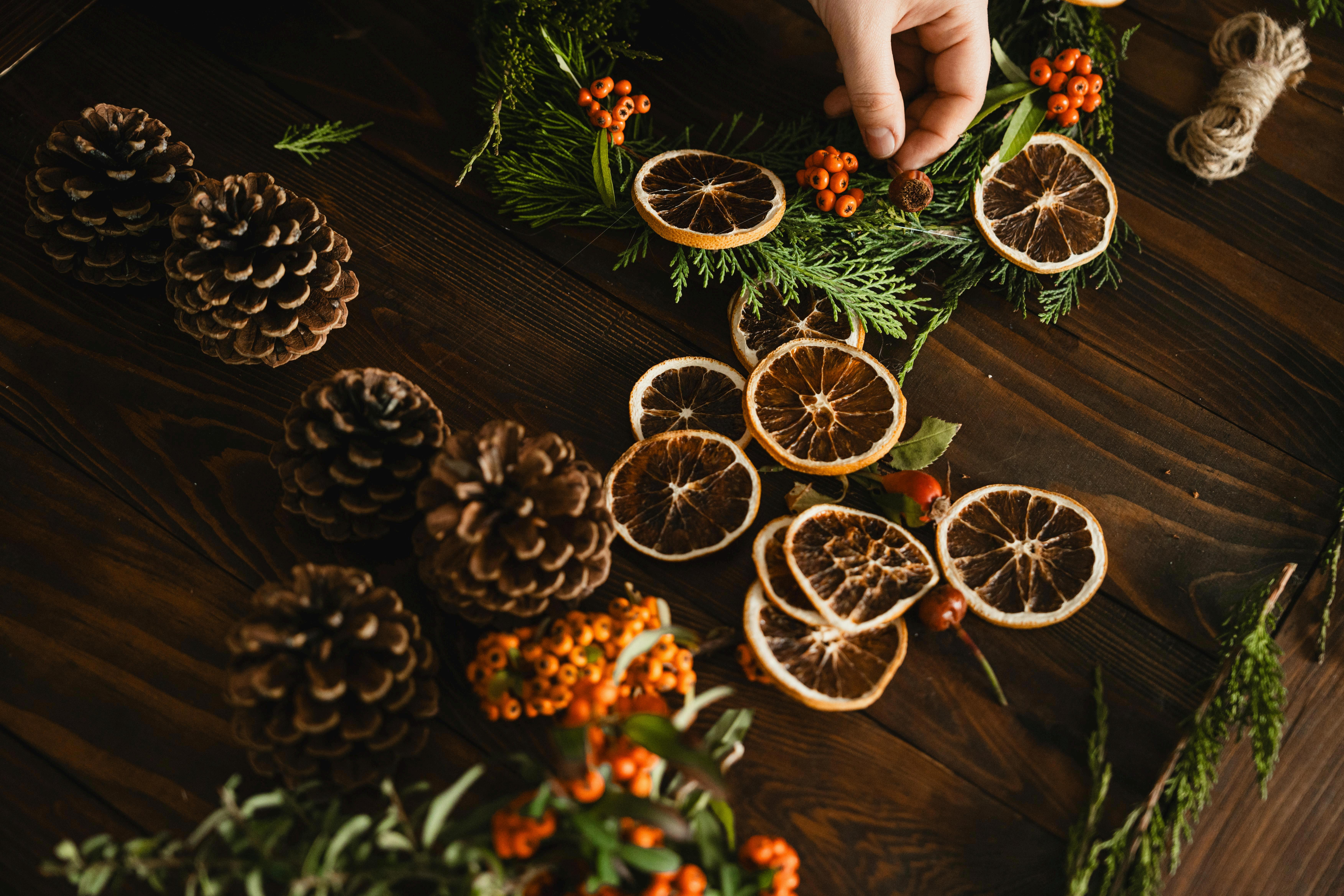

By November, the field feels like it’s exhaling. The rush of summer is a memory now, and the beds are soft with fallen leaves and damp soil. The work shifts from harvesting to tending, from colour to care. It’s a slower rhythm, but still full of purpose.
The new polytunnel – part gifted by Premier Polytunnels – is already proving its worth Inside, trays of hardy annuals are quietly growing on, sheltered from the wind and rain that batter the Wirral this time of year It’s a small world of green in the middle of all the grey, and it makes you realise how much hope can live in a seed tray
Out in the beds, the dahlias are being left in the ground this winter, mulched heavily to keep them cosy through the cold months It’s a bit of a leap of faith, but one that’s often rewarded – less disturbance, less lifting and storing, and a little more trust in the soil to do its work The rest of the field is getting the same kind of care: paths weeded, compost spread thickly, and everything tucked up for a long rest
As the growing slows, our attention turns to people as much as plants. The winter workshops are in full swing – wreaths, dried flower designs, and a good dose of conversation around the table. It’s the part of the year that reminds us why we do this: connection, creativity, and the steady joy of working with what’s been grown.
We’re already planning next year ’ s workshop calendar too – more hands-on sessions, more ways to learn and grow alongside the flowers The new tunnel will give us space to start things earlier, to explore propagation and seed sowing with others who want to give it a go It’s exciting to think how this new space will shape the seasons ahead
November might seem subdued, but it’s quietly full of life –seedlings stretching in the tunnel, bulbs settling into the soil, and plans already unfolding for next year
You can visit the Wirral Flower Farm for pick your own, weddings and workshops (see starting dates below) : Check out Jen’s website for all the new courses available for 2026

November might bring darker, shorter days and misty chilly weather but it’s also a great time to start thinking about those winter jobs now that the growth has slowed and plants are starting to die back for the winter ahead.

Flowers
Spring bulbs-daffodils, crocus, hyacinth, tulips
Cornflowers
Calendula
Sweet Peas
Nigella (love in a mist)
Poppies
Monarda
Edibles
Winter Lettuce
Spinach
Broad Beans
Spring Onions
Autumn Onion sets
Garlic
Pak Choi
First early Peas
Come and join the @gardenfolkmag team for live garden updates throughout the month over on Instagram.

What to listen to while you sow:

Each week, host Bex Lindsay visits a different Forestry England site to discover the hidden joys and wonders of wild spaces From arts to history, wellbeing to wildlife, she’s on a quest to learn more about the nations forests and the people who spend time in them.


As Autumn comes to a close its time to tidy, mulch, pop on your hat, and get stuck into those outdoor jobs before the ground freezes
Bring potted herbs indoors to continue cropping as the season gets colder
Lift and store dahlia tubers.
Prune autumn fruiting raspberries down to the ground once they finish fruiting.
Start harvesting Jerusalem artichokes
Clear/cut back annual climbers from their supports
Insulate the greenhouse walls and roof
Prune fruit bushes and take a few hardwood cuttings to increase your stock next year.
Start planting spring bulbs
Plant tulips in at least twice their depth in the ground. Fill a pot by the door with them ready for a pretty spring display.
Continue to plant garlic and autumn onion sets
Protect new shoots from birds
Keep sowing winter salads.
Propagate perennials from root cuttings

If you’re in need of Garden related ‘stuff’ remember that Garden Folk Supporters get some amazing discounts with some great companies!
Set the date for December 5th for the next issue